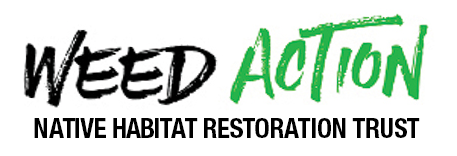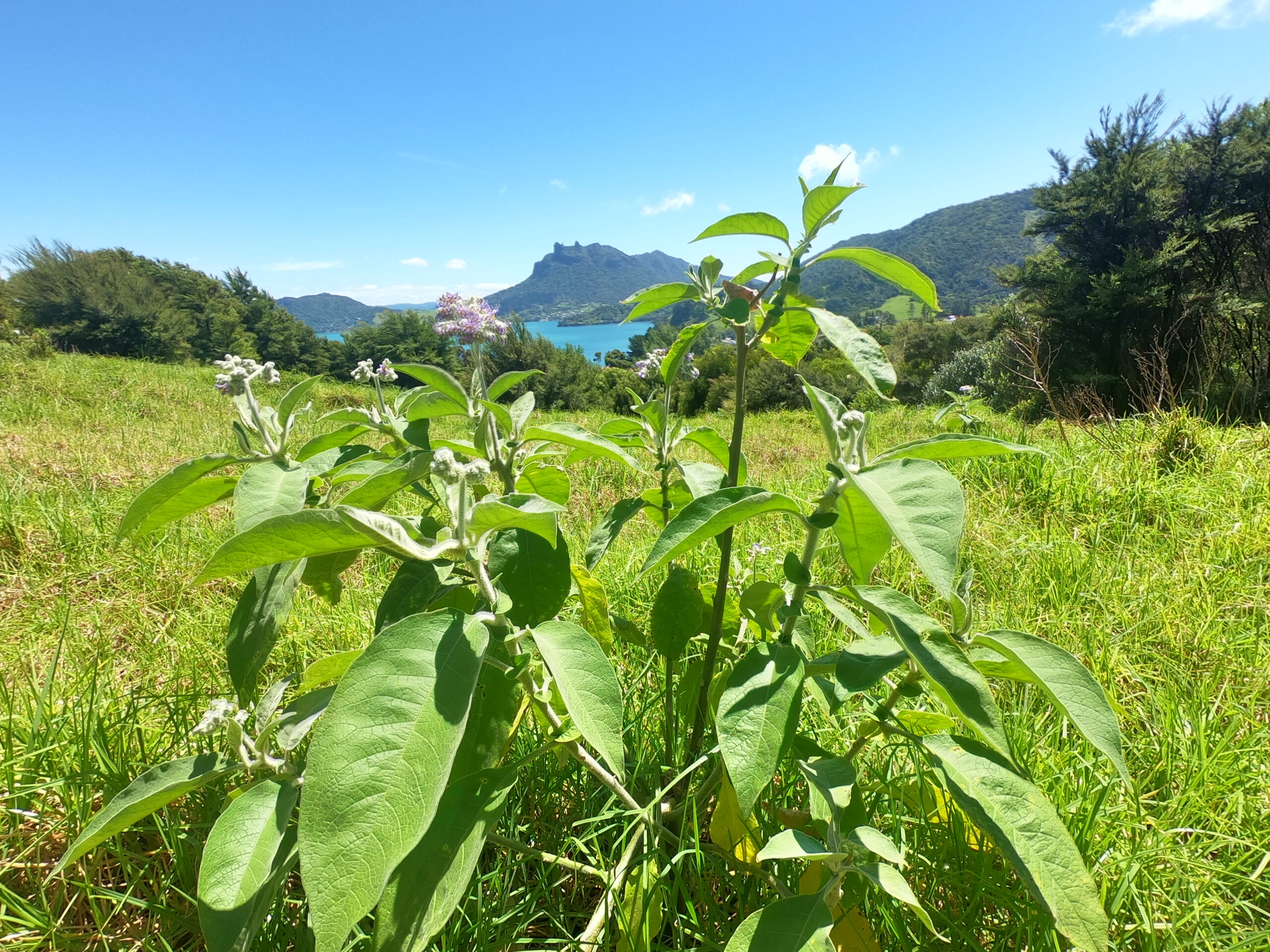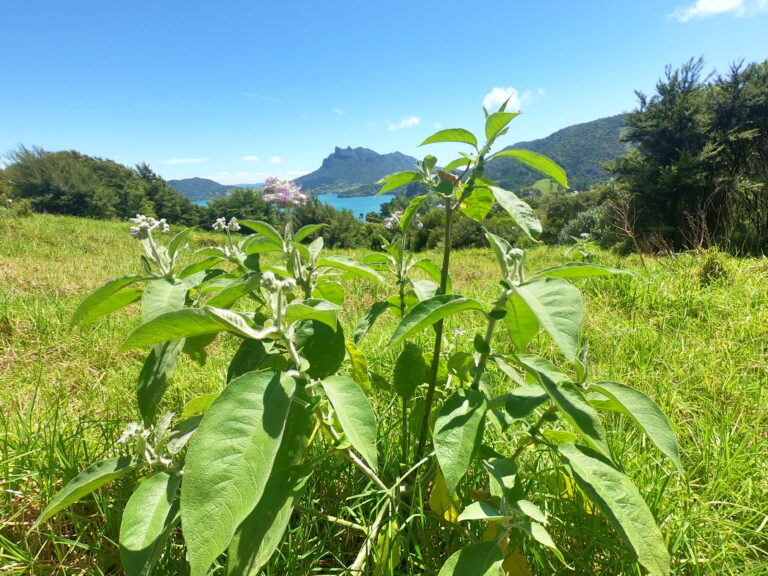1 JULY 2021 – 30 JUNE 2022
Whaka ora Reotahi Volunteer Group
Summary
This report is an overview of work achieved over the 5 landscape scale programmes Weed Action Native Habitat Restoration Trust (WANHRT) operates. The work is aligned with the boundaries of the Whangārei Heads peninsula which encapsulates Manaia Ecological District – Northland regions’ smallest district at 6400 ha with the highest percentage of natural cover across the spectacular terrain.
2021/22 has been a year of big achievements, disruptions and change, including the impacts of delivery through Covid 19 restrictions. Our first year of operation as a Charitable Trust and the associated work has been a big stretch for us. We owe a big thanks to Ngaire Sullivan from Kiwi Coast for providing funding for Wendy Ambury to set up our Xero accounting system. Wendy is now part of the team and supplies both our financial and administrative support plus Health and Safety management and oversight. Having solid systems in place has enabled us to attract more funding and grow our project based work.
We were sad to see Kelly Maxwell, our HVA Coordinator, leave in August 2021 however we regrouped and team member Mike Urlich filled the Coordinator position with the community engagement and publicity role placed in the capable hands of Hadden Morrison. Despite disruptions, we managed to grow our volunteer base, maintain community groups and help develop local hapu weed control team Aki Tai Here (ATH).
A big boost for our morale this year has been the Parliamentary Commissioner for the Environment `Space Invaders’ report as it helps validate our cause. This report used WANHRT as a case study and enabled us to convey the urgency of investing in weed work to mitigate against loss of biodiversity.
Here are five programmes that link up and provide a landscape scale approach to our work across our complex and stunning landscapes:
1. Landowner Support
2. Reserve and Public Conservation Land Restoration
3. Conservation Land Buffer Zone
4. Privet Control and Parua Bay Privet Buffer
5. Waka Hourua Partnership
- Landowner Support
Our landowner support programme is primarily funded via the Northland Regional Council – High Value Area. This NRC annual contribution enables WANHRT to provide biodiversity expertise, promote weed awareness to the community and leverage funding for work on reserves and Public Conservation Land. It also provides the Health and Safety umbrella to engage sub-contractors including awhi local hapu members to do mahi on the whenua.
With the broad distribution of high impact weeds in Whangārei Heads a multi-faceted strategy is needed. From a ‘hearts and minds’ approach to engage the community, developing partnerships with tangata whenua to our standalone privet buffer in Parua Bay.
Department of Conservation & WANHRT working together at Ocean Beach in February 2022
Landowner Programme – Key Objectives
- Removing Barriers to Action
Publications – The bimonthly Whangārei Heads newsletter continues to get our message on the impacts of weeds out there and our quarterly newsletter “The Word on Weeds” provides the community with weed identification and project updates. A generic WANHRT flyer is now available for distribution to give to new homeowners, Kiwi release events and Cafe’s. In the last 6 months we have targeted the Nook and Reotahi communities with letterbox drops, informing landowners about our service and engaging them to take action
Weed Amnesty – A moth plant skip was placed outside the community centre in Parua Bay for April that collected and prevented 10 million moth plant seeds from blowing around the Heads! An additional Weed Amnesty bin for May and July yielded a variety of pesky weeds
Networking
WANHRT have met with DOC and have organised two DOC volunteer events per year, alongside an agreement to annually have contracting staff control moth plant at Proctors Beach. We have also arranged a DOC facilitated WANHRT working bee this August. Mike has worked with Northtec students, providing a half day’s work on Manaia.
Two moth plant working bees were held; a Moth Plant Mob event at School Road in March and a working bee on the Ross property were held to support Murdoch who is an amazing community stalwart. With support from the Parua Bay Tavern we provided prizes in a moth plant competition alongside facilitating a working bee on the Wharf Road road verge and the Kohinui Stream. In the 3ha WDC owned Coles Bush we have engaged a keen volunteer to be a kaitiaki of this reserve and manage weed and pest control works.
- Community Engagement
Landowner Advice, herbicide allocations and Trailer
The community is kept informed about Weed of the Month identification and methodology through Facebook posts, newsletters, signage and targeting roadside weeds. Mike has responded to landowners seeking support to deal with weeds and provided them with herbicide and advice. The WANHRT trailer is a great way to engage the community, is used at our Weed Action working bees/ events and it’s a great advertisement.
Weed Action events. Engaging the community to be part of Weed Action groups is our ‘call to action’ and while consistent volunteers can be hard to find, we have a steady number of great supporters who turn up at each event with 3 of the 8 Weed Action groups operating independently only calling on Mike for equipment advice or herbicide. We have developed a Memorandum of Understanding with the Whangārei District Council to support our work on their reserves and annually assess the needs and plans for volunteer groups. Mike has developed weed plans for the key Weed Action volunteer sites including The Nook, Reotahi, Ocean Beach, Mt Manaia, Richie Rd, Cole’s Bush and Tamaterau.
Young weed warrior pulls out moth plant
c. Telling the Habitat Restoration Story
In 2022, we have placed emphasis on collating before and after images so that we can track habitat restoration and are able to show the community the value of removing weeds. While our goal to start mapping using tools such as ArcGIS eluded us this year, Frank Bates has started retrospectively mapping the sites we have been working on.
d. Strategic Weed Control
Annually we set aside $3000 Strategic Funds for particularly infested areas . We identified a large coastal property with significant areas of Elaeagnus that can spread to the DOC estate. The landowner was heartened by this support and will continue to invest in weed work.
Dead and dying elaeagnus amongst native regeneration located in McLeod’s Bay
BY THE NUMBERS FOR 2021/2022
| Value ($) of other funding obtained Lottery Environment Fund: Whaka Ora Reotahi $53,000World Wildlife Fund: Aki Ngāhere o te taiao ki Pātaua $15,000Lottery Northland: Aki Tai Here – Gear Up $6700. CPCA Pataua Sth: $8000, Whangarei District Council: $15,000 TOTAL: $91,000 Large scale contractor hours on PCLs and reserves: Manaia: 401 hoursReotahi: 362 hoursThe Nook Reserve: 67 hoursRichie Rd Reserve: 32 hoursBream Head: 24 hourColes Bush Reserve: 20 hours TOTAL: 904 hours |
2. Conservation Land Buffer Zone Programme
WANHRT engages landowners on adjoining ‘buffer zones’ of reserve and PCL and supports them to gain funding through the Northland Regional Council BioFund programme. Our recent focus is to work with several landowners at Taurikura ridge including QEII National Trust covenanted land. Through working with these landowners we are helping to link the landowners on Taurikura which helps reduce the incoming weed burden to Bream Head, Reotahi and Manaia. The Leahy family have committed huge resources to restoring invaded bush remnants in the Manaia buffer zone and received assistance which was used on Aki Tai Here contractor time.
3. Reserves and Public Conservation Land Programme
WANHRT provides support and training to Weed Action volunteers working on iconic PCLs / reserves and has successfully received funding for engaging contractors such as Aki Tai Here for the steep forests on parts of Manaia and Reotahi that are too difficult for community groups.
The $15,000 received from WDC helped our work on the WDC 35ha of invaded forest that links Whangārei Heads Rd and Mt Manaia. This is a key ecological link for native biota, and when restored will take the forest from the ‘mountain to the sea’. The Aki Tai Here team have cut access tracks through areas infested with; gorse, woolly nightshade, ginger, elaeagnus, banana passionfruit and queen of the night. This work has been complemented by Manaia Bush Recovery Group (MBRG) who are working the block towards the coast. It is hoped that in the next 2 years all areas within this 35 ha will have had initial control.
4km ATH tracking + initial control work on 35ha WDC land under Manaia and MBRC (blue)
L to R: ATHI Team – Mike, Kauri, Ray and Tiu take a breather at launch day
Early in 2022 we received funding from NZ Lotteries to assist with the restoration of a weed-invaded Reotahi. WANHRT stressed in the funding application, the importance of involving local hapu on this culturally significant site. In February we launched the Waka Ora Reotahi project as a tangata whenua and WANHRT collaboration.
4. Privet Control and Parua Bay Privet Buffer
Jan continues to manage this programme which has extended to 38 landowners and 450 contractor hours being matched by landowners. This project is a slow burn but the impact of removing thousands of large privet is doing a great job to reduce the spread out to the heads.
5. Waka Hourua partnership
WANHRT’s connection with local hapu continues to build both with the ATH team and engaging in hui, as we work together to access funding for the restoration of Manaia. Local hapu members are keen to see matauranga Maori principles in practice on Manaia and we are working to support this. Led by Nikki Wakefield, any application for Manaia will include the local Aki Tai Here team to do the mahi. This team has become a dynamic and skilled weed control group, able to identify and work with over 50 environmental weed species. At the beginning of this year, WANHRT were successful in accessing $15,000 from the World Wildlife fund (WWF). This money is being used by ATH in Pataua to control pest plants affecting the native habitats on their whenua. The WWF funding supported the hapu to access further support from NRC in the form of a hapu led 5 year CPCA with NRC.
Recently Nikki Wakefeild accompanied Kauri, Mike and some Ngāti Wai members from Kauri Ora (Hapu led Kauri dieback programme) on a field day at Manaia to explore how our two teams can work collaboratively in protecting the forest taonga.
Nikki out on a Manaia field trip with Kauri ora teams exploring ways of collaborating
Our priorities for 2022/23
- Access funding for Manaia which last year received only $6000 for weeds work for elaeagnus – it is a priority site.
- Secure funding for key weed sites and sustain the ATH team. A pool of strategic weed funds would enable us to target infestations that don’t fit current budget streams.
- Engaging the community further. This could be through the establishment of small local Weed Action pods geographically spread across Whangārei Heads.
- Engage landowners around the Reotahi project Buffer Zones further with herbicides already provided by NRC in a successful June Biofund bid.
- Consolidate the team and grow our capacity to show the largely unseen restoration story we are engaged in.


